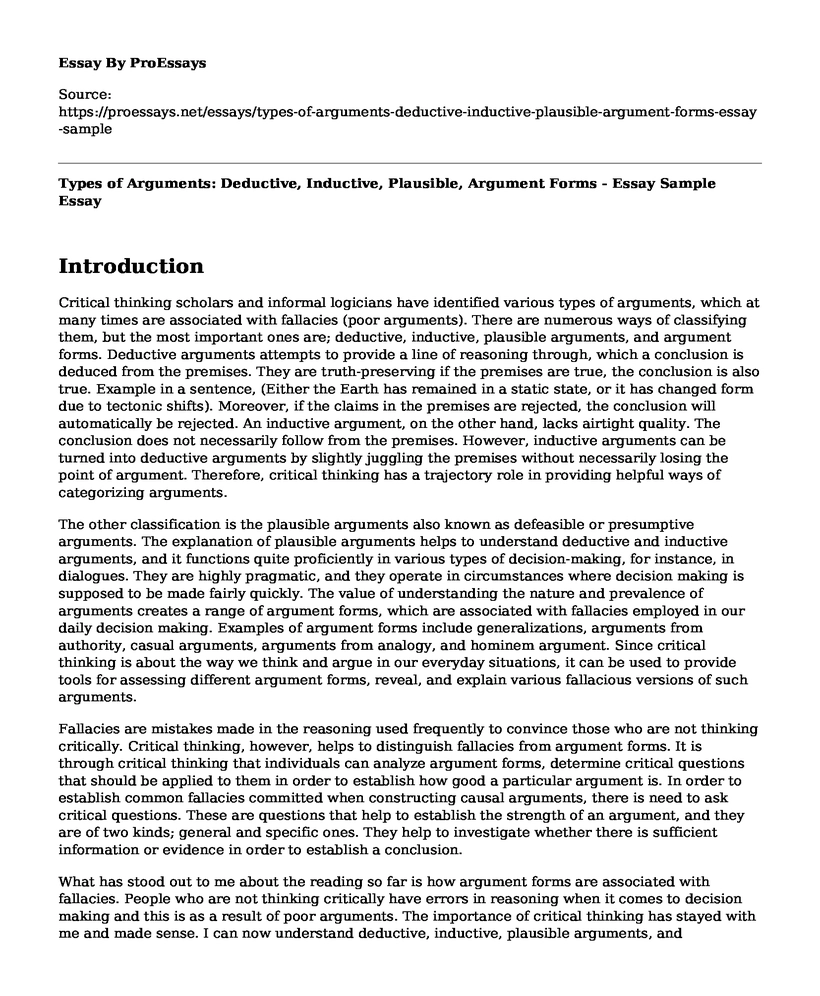Introduction
Critical thinking scholars and informal logicians have identified various types of arguments, which at many times are associated with fallacies (poor arguments). There are numerous ways of classifying them, but the most important ones are; deductive, inductive, plausible arguments, and argument forms. Deductive arguments attempts to provide a line of reasoning through, which a conclusion is deduced from the premises. They are truth-preserving if the premises are true, the conclusion is also true. Example in a sentence, (Either the Earth has remained in a static state, or it has changed form due to tectonic shifts). Moreover, if the claims in the premises are rejected, the conclusion will automatically be rejected. An inductive argument, on the other hand, lacks airtight quality. The conclusion does not necessarily follow from the premises. However, inductive arguments can be turned into deductive arguments by slightly juggling the premises without necessarily losing the point of argument. Therefore, critical thinking has a trajectory role in providing helpful ways of categorizing arguments.
The other classification is the plausible arguments also known as defeasible or presumptive arguments. The explanation of plausible arguments helps to understand deductive and inductive arguments, and it functions quite proficiently in various types of decision-making, for instance, in dialogues. They are highly pragmatic, and they operate in circumstances where decision making is supposed to be made fairly quickly. The value of understanding the nature and prevalence of arguments creates a range of argument forms, which are associated with fallacies employed in our daily decision making. Examples of argument forms include generalizations, arguments from authority, casual arguments, arguments from analogy, and hominem argument. Since critical thinking is about the way we think and argue in our everyday situations, it can be used to provide tools for assessing different argument forms, reveal, and explain various fallacious versions of such arguments.
Fallacies are mistakes made in the reasoning used frequently to convince those who are not thinking critically. Critical thinking, however, helps to distinguish fallacies from argument forms. It is through critical thinking that individuals can analyze argument forms, determine critical questions that should be applied to them in order to establish how good a particular argument is. In order to establish common fallacies committed when constructing causal arguments, there is need to ask critical questions. These are questions that help to establish the strength of an argument, and they are of two kinds; general and specific ones. They help to investigate whether there is sufficient information or evidence in order to establish a conclusion.
What has stood out to me about the reading so far is how argument forms are associated with fallacies. People who are not thinking critically have errors in reasoning when it comes to decision making and this is as a result of poor arguments. The importance of critical thinking has stayed with me and made sense. I can now understand deductive, inductive, plausible arguments, and arguments forms, and through critical thinking, I can establish the strength of an argument.
Cite this page
Types of Arguments: Deductive, Inductive, Plausible, Argument Forms - Essay Sample. (2023, Feb 16). Retrieved from https://proessays.net/essays/types-of-arguments-deductive-inductive-plausible-argument-forms-essay-sample
If you are the original author of this essay and no longer wish to have it published on the ProEssays website, please click below to request its removal:
- Essay Example on Management: Leadership Challenge in an Organization
- Why Do You Do What You Do: Walmart Company Analysis
- Research Paper on Political Leadership
- Essay Sample on Leadership Skills for Volatile, Uncertain, Complex and Ambiguous Organizations
- Essay Example on Safety First: Improving Transportation Security Together
- On-Campus Students: Battling Crime and Social Evils - Essay Sample
- Paper Example on Constructing an Effective Team: Selecting the Right People







